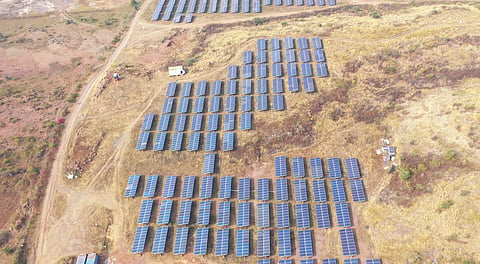

India is set to become the second-largest growth market as global renewables will expand 2.5 times by 2030; however, grid and financing gaps threaten momentum, according to a new report.
International Energy Agency’s (IEA) Renewables 2025 report, released on October 7, said global renewable power capacity is on track to double by 2030, adding nearly 4,600 gigawatts (GW) of clean energy — equivalent to the combined electricity capacity of China, the European Union and Japan.
The report warns, however, that the world remains off pace to meet the COP28 pledge of tripling renewables by the end of this decade unless countries move faster on policy implementation, grid expansion, and financing reforms.
“Despite remarkable momentum, the global energy transition is still not fast enough to hit the tripling target. Grid bottlenecks, rising financing costs, and policy uncertainty remain the biggest barriers,” said Heymi Bahar, the report’s lead author and senior analyst at the IEA.
Solar photovoltaic (PV) systems continue to dominate the expansion story, accounting for nearly 80 per cent of global renewable capacity growth. By 2030, solar PV alone is expected to generate more power than hydropower — becoming the world’s largest renewable source of electricity. Wind power, both onshore and offshore, follows as the next major contributor, while hydropower and geothermal maintain modest growth.
Globally, renewables are projected to supply 43 per cent of electricity generation by 2030, up from 32 per cent in 2024. The share of variable renewable energy — mainly wind and solar — is set to almost double to 28 per cent, underscoring the urgent need for system flexibility, battery storage, and smart grids to manage intermittency.
“We’re entering an era where variable renewables dominate the power mix. The challenge is no longer deployment, but integration,” Bahar added.
Among major economies, India’s renewable outlook stands out. The country is poised to become the second-largest growth market for renewables, with capacity expected to increase 2.5 times by 2030. The report attributes this to record auction volumes, improved rooftop solar support, and faster hydropower permitting.
“India’s progress reflects a shift from ambition to implementation,” Bahar said. “Faster auction cycles and growing investor confidence have helped, but transmission expansion and discom (distribution company) financial health will be critical to sustain momentum.”
Under the IEA’s “accelerated case,” India could surpass its 2030 target if states address payment delays, sign pending power purchase agreements (PPAs), and strengthen renewable portfolio obligations.
The report notes that while variable renewables’ share in India’s grid remains relatively low due to growing power demand, state-level concentrations — particularly in Rajasthan, Gujarat, Tamil Nadu, Maharashtra, and Karnataka— will require “significant investment in grid and flexibility solutions.”
Outside India, the picture is mixed. While China continues to drive nearly 60 per cent of new global renewable additions, policy shifts there — such as the move from fixed tariffs to market-linked auctions — have moderated growth expectations. The United States’ forecast has been revised down by almost 50 per cent due to expiring tax credits, import restrictions, and regulatory changes.
Europe’s outlook is marginally brighter, buoyed by corporate power purchase agreements and solar PV growth in Germany, Spain, Italy, and Poland, even as offshore wind projects face cancellations and supply chain delays.
“The renewables industry is expanding faster than ever, but not evenly,” Bahar said. “While developers remain bullish, manufacturers, particularly in wind and solar, are under severe financial strain due to overcapacity and collapsing prices.”
The IEA warns that without stronger coordination between governments, grid operators, and financiers, the global renewable push could fall 10-15 per cent short of the tripling goal.
“Tripling global renewable capacity by 2030 is still within reach — but it demands faster permitting, more investment in grids, and mechanisms that de-risk private capital,” said Paolo Frankl, head of the IEA’s Renewable Energy Division.
In short, the Renewables 2025 report paints a cautiously optimistic picture — record installations, falling solar costs, and surging auctions show the energy transition is accelerating. But unless nations bridge the gap between ambition and action, the world risks missing its most achievable climate milestone.